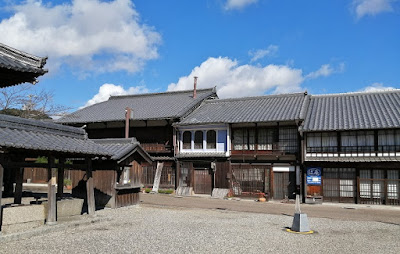One more survived inn town
We once visited two nostalgic inn-towns, Tsumago(妻籠) and Magome(馬籠) where many historical buildings are survived. The inn-towns were located in the Nakasendo(中山道), an ancient highway made in the early Edo period.
And also these were 42nd and 43rd inn towns from Edo(江戸) city. These highways not only this Nakasendo but also numerous other ancient highways were developed dramatically. Roads were widened and surfaces were changed into asphalt.
Because modern society needed the changes. Speaking of the Nakasendo, only 42nd and 43rd inn-towns were survived. These towns were relatively inconvenient for the modern people's transfer. New route was developed and these inn-towns were isolated.
Is there any survived inn-town?
Clue to the investigation is to focus on highways made in the Edo period. We once mentioned that the most famous highways between Edo and Kyoto(京都) were two. These were the Tokaido(東海道) along the coastal area and the Nakasendo in the inland area.
And this time we found that another inn-town in the Edo period is also survived in the Tokaido route. That is "Seki-shuku(関宿)" which we visited this time. In our understanding, all of inn-towns in the Tokaido have been changed and historical buildings aren't remained. However, that is our misunderstanding. Another inn-town is still survived in Kameyama(亀山) city Mie(三重) Pref.
One reason is because it's located not in a coastal area but in a mountainous area. Then, the population in the town was rerely changed. And also the town was not changed because of the development or reformation. One more reason we suppose is the existence of the Kameyama city. It's located quite near of the Seki-shuku. So, people move there and it remained escaping the development.
Take a walk in the Seki-shuku
This inn-town is now a residential and commercial area along the former Tokaido highway. The length is approximately 1.8 kilometers and the width is two 200 to 300 meters. The main road (former Tokaido highway) is not wide to ride vehicles, so, only locals' compact cars can pass through.
In the Edo period, the property taxes were defined according to the width of contact between the property and the road. Then, the premises were usually narrow width and deep depth.
The town's premises haven't been developed until now. However, wooden buildings relatively easily deteriorate, so, some kind of renovation was necessary. Half of the buildings are made during the Edo period and the Meiji period. And also the buildings made before WW2 are 70 percent and more. From these scores, you can imagine that there are still old townscapes and many aged buildings.
And more, the buildings made recently have appearance concerning the town's atmosphere.
The central facilities for tourism are a townscapes culture center and a history museum.
The townscapes culture center is in the building which was used as "Honjin(本陣)". What is "Honjin"? "Honjin" was a facility where the Daimyo(大名) party stayed the night in the Edo period. Every inn-town had a few "Honjin" facilities to serve the needs of the Daimyo parties' travel. And also, the history museum is in the building used as "Hatago(旅籠)". What is "Hatago"? "Hatago" was a hotel in the Edo period. So, both facilities are reuse of aged buildings. Let's investigate the townscapes culture center. Almost all buildings in the "Honjin" were ruined and only few are survived as a facility. You can look at Honjin's administrator's space, a storehouse and so on.Then, how about the history museum? In the history museum, you can appreciate almost all "Hatago" buildings at that time. The entrance area, the owner's work space, VIP people's areas, the bathroom, the courtyard and many other places.
Maybe this building is very well survived. When you visit upstairs, you can look at how traveler's sleep in this inn. A traveler's sleeping area and the other room are separated by only thin sliding doors. Can you sleep well there? We doubt.
There are many shops reused aged buildings, for example. In the canter or slightly western area, there is a very beautiful temple named "Jizoin(地蔵院)". This temple is a kind of symbol of this town. It was constructed around 1700, and registered as an important cultural asset.
There is one more facility we want to mention here, that is "Chokantei(眺関亭)". It's an observatory. But the exterior looks like a private house. You can observe the whole scenery of this town from here. Backside of this building is a small public park called "Hyakurokutei(百六庭)".
There are very few domestic travelers. And many shops are temporarily closed. We hope this will change soon.
"Inn town in the Edo Period"
Please visit to remember these inn towns.










